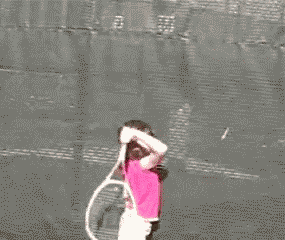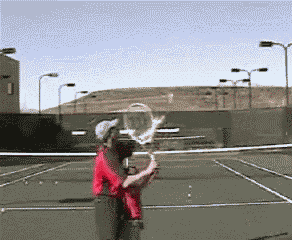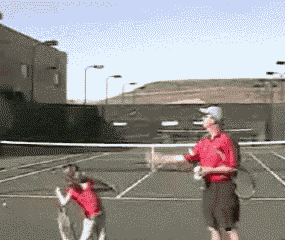| TennisOne Lessons Training an 8-Year Old: Part 3 Developing the Proper Foundation for the Serve David W. Smith, Senior Editor TennisOne As this series continues, I am going to be showing you how we introduced Kyla (my daughter) to the serve and the progression we took in developing a consistent—but more importantly—an effective spin serve, one that will continue to improve as she matures without requiring specific changes in the grip, swing pattern, or body position.
As with all our beginner programs, we start out players learning to volley first. (See last month’s issue). The importance of learning the continental grip through learning to volley carries over into other shots like the two-handed backhand (for the dominant hand’s position) and especially for the serve. When working with kids and especially girls, the overhand motion of the serve coupled with the complexity of making contact with a ball tossed up over the head (instead of a ball tossed towards us, which is usually more familiar for kids), is often unfamiliar and therefore difficult. Most youngsters have not done many activities which involve the overhand throwing motion. Young kids will usually toss underhand to each other when playing simple games of catch. Very few girls have ever thrown a football before the age of 8. And even fewer kids have tossed a ball over their head and tried to hit it with a racquet! Keeping in mind these very limited experiences, teaching a child to serve is like teaching them how to walk when they were toddlers. While the steps I will be showing you certainly will provide a foundation that will help youngsters serve well relatively quickly, it must be understood that there is a definite progressive pattern to learning to serve well. Certainly, I or anyone else could teach a kid to “paddy cake” the serve. Using the simple eastern forehand grip and pushing the ball towards the net, almost anyone can learn to get the ball in the general vicinity of the service box and even become fairly consistent with it in a very short period of time. However, as most tennis-playing adults can often relate to, changing a grip, swing path, and body position is one of the most difficult things to do once a player starts “playing tennis” with questionable or ineffective techniques.
In my 35 years of teaching tennis, I can tell you that without a doubt, it doesn’t take much more time or effort (compared to the time or effort by those who are taught more simplistic modes of hitting the serve), to teach more advanced service techniques to very young kids. Much like the volley, serving well has very little to do with strength, and everything to do with technique. As with anything, if a student continues to employ a swing or footwork pattern that is initially unfamiliar, what was once uncomfortable will become comfortable. However, if we start off using comfortable, familiar methods, those which will need to change if we hope to advance at some point, we only ingrain patterns that much more and ultimately, making changes to those ingrained patterns becomes almost impossible! The Serve: Within the Advanced Foundation The system I teach is called the “Advanced Foundation.” The concept is to teach any potential tennis player methods that do not have to change for advanced skill levels to be reached. While evolution and player idiosyncrasies will guarantee some element of change as any player develops, the concept of a necessity to change (to more advanced grips and swing and footwork patterns) is the very concept that insures player stagnation and failure to reach their true tennis potential.
The serve, like the volley, is one of the weakest shots among players who stagnate at levels below their ability. Specifically, the ability to hit a strong second serve is the sticky point among such players; but also, the ability to hit more effective, more consistent first serves is directly related to a player’s ability to hit effective second serves. Both serves are dependent upon spin. Forget the phrase, “Flat Serve.” There is no such thing. Players on tour, serving well over 120 mph hit with significant spin, upwards of 2000 rotations per minute (rpm) on a so-called flat serve. Second serves are exponentially higher, with players reaching ball-rotation speeds of over 4000 rpm’s. Unless a player is introduced to the concept of spin, few will not be able to achieve an optimal amount of spin (based on their racquet head speed) nor will they probably hit the right kind of spin. The serve we teach first is the slice. The slice provides the student the easiest spin service motion and it teaches the student how a ball with spin will behave in the air. It is a lot of fun for kids to see that they can make a ball curve. It is usually something so new and almost magical, that they really get a kick out of seeing the ball curve.
The slice also promotes the action of the “edge-on” component as it typically gets kids to lead with the leading edge of their racquet instead of leading with their hand or leading with a flat racquet face to “push” the ball into the court. Serve Progression
Step Three: The toss and brush. Move kids up to the service line when first introducing the toss and brushing action. I have found that it is far more productive to get kids and beginning adults alike, to learn the action of the racquet on the strings than spending time on backswing patterns. I like to initiate the slice serve from a short backswing pattern, holding the elbow high and the racquet half-way back. While I don’t have a problem using the “Back Scratch” teaching phrase if I need to get players to drop their racquet head more later on, I don’t specifically use that phrase or that position to start. By starting kids up at the service line, they are not as apt to try and swing with their body and lose their balance or revert to using the eastern forehand grip. This is very common when teaching kids to serve from the baseline. Because the combination of the unfamiliar continental grip and the spin of the ball (hitting a ball with spin doesn’t go as far as a ball hit flater), moving the kids up to the service line helps them better work on the technique. I'd much rather see kids use the right technique than get the ball in the target area. Certainly using targets provides a sense of success (or failure!); however, when players are introduced to targets too early, they will try any way that feels most comfortable to achieve the target. I promise you that in time the proper technique will achieve target success! (It is a little like learning to play the piano, if you expect a kid to play a complex song too soon they will not be able to coordinate the fingers in the right sequence. By developing the fingers through progressive—but proper—patterns, they will gradually be able to play more and more difficult songs with success.)
Step Four: Gradually serve from deeper and deeper in the court. As players become more comfortable with the grip, the brushing action, and the timing of the motion, back up and get them to learn to aim higher and more to the right (for right-handers) until they can serve from the baseline. It didn’t take long for Kyla to start getting her slice serve in with some regularity. It took about a month for her to put it all together and really experience success from the baseline.
Guide Serve Drill: Stand behind the child and, tossing the ball for them and holding their racquet hand with them, swing the racquet with them. I did this for Kyla once then had her try by herself. I would repeat this and gradually she developed the swing path we were working on. (She didn’t like it when I did this, “I want to do it myself,” was the common retort - but, no question, this drill helped her.
Serving from the Knees: Because many kids will “over-use” their legs and body, it is sometimes helpful for them to practice serving from their knees. This will also help them to learn to “hit up” on the ball for topspin. Make sure they kneel down sideways to the net. This also helps them learn to toss more consistently. The serve should be a weapon for all players since it can be practiced without a hitting partner, and it is the one shot that the player has full control of from the start and gets two chances to get it right. Unfortunately, millions of tennis players learned to serve within the context of simple, rudimentary methods (to “get the ball in”) and, as a result of this learning pattern, stagnate with a serve that is far below that which they should be able to achieve. By teaching kids (and adults) in the patterns I have outlined, I guarantee you that no player will stagnate because of a sub-par serve! Your comments are welcome. Let us know what you think about Dave Smith's article by emailing us here at TennisOne .
TENNIS MASTERYFinally. a resource that unlocks these mysteries: • Why do m • Why are making changes in one's game so frustratingly difficult? • What tennis teaching methods are disruptive or detrimental to player progression? Read David W. Smith's TENNIS MASTERY and learn not just how to avoid playing at mediocre levels, but how the best players in the world Master the sport of tennis! "With a depth of knowledge and fresh perspective, TENNIS MASTERY is set to become a manual for tennis instructors and a measure for tennis literature." Richard Wigley, Director, Kayenta Tennis Center, Ivins Utah. Take in David Smith's 30 plus years in the tennis teaching industry. This 335-page manual will provide for every level of player as well as support for all tennis-teaching professionals, a blueprint for reaching higher levels of tennis mastery. Order TENNIS MASTERY at tenniswarehouse.com , or go to tennismastery.net for exciting excerpts from the book and a host of tennis information! And check out David Smith's other articles found here at TennisONE.com |




 illions of tennis players stagnate at levels far below their potential?
illions of tennis players stagnate at levels far below their potential?